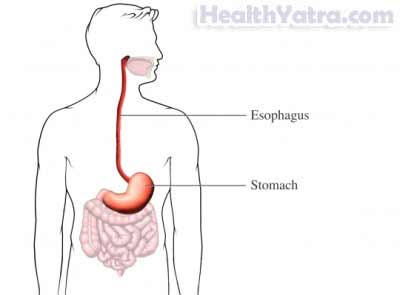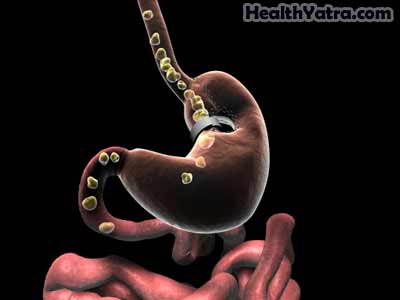সংজ্ঞা
Vertical banded gastroplasty is surgery to treat obesity. It causes weight loss by decreasing the amount of food you can eat.

পদ্ধতির কারণ
The surgery treats severe obesity. Doctors use a calculation called body mass index (BMI) to determine how overweight or obese you are. A normal BMI is 18.5-25.
This surgery is a weight loss option for people with:
- BMI greater than 40
- BMI 35-39.9 and a life-threatening condition, such as heart disease or diabetes
- BMI 35-39.9 and severe physical limitations that affect employment, mobility, and family life
The success of vertical banded gastroplasty depends on your commitment. If lifestyle changes are made and maintained, the benefits of bariatric surgery include:
- Weight reduction
- Improvement in many obesity-related conditions, such as glucose intolerance, diabetes, sleep apnea, high blood pressure, and high cholesterol
- Improved mobility and stamina
- Enhanced mood, self-esteem, and quality of life
- Reduced risk of dying from cardiovascular disease (eg, heart attack, stroke) and other causes
সম্ভাব্য জটিলতা
If you are planning to have gastroplasty, your doctor will review a list of possible complications, which may include:
- Vitamin deficiencies—You will take a multivitamin daily for the rest of your life.
- রক্তপাত
- সংক্রমণ
- রক্ত জমাট
- বমি
- Breakdown of the staples, allowing stomach juices to leak into the abdomen
- Slipping or wearing away of the band
- Enlargement of the pouch
- Irritation of the throat due to acid reflux
- Hernia formation
- Complications of general anesthesia
- Death, occurs in less than 1% of patients
জটিলতার ঝুঁকি বাড়াতে পারে এমন কারণগুলির মধ্যে রয়েছে:
- ধূমপান
- Recent or chronic illness (eg, kidney disease)
- ডায়াবেটিস
- Old age
- হার্ট বা ফুসফুসের রোগ
- Bleeding or clotting disorders
কি আশা করা যায়
পদ্ধতির আগে
Each bariatric surgery program has specific requirements. Your program will likely include the following:
- Thorough physical exam and review of medical history
- Attempts to lose weight (about 10%) through medically approved dietary means
- Ongoing consultations with a registered dietitian
- Mental health evaluation and counseling
আপনার পদ্ধতি পর্যন্ত নেতৃত্ব:
- Talk to your doctor about your medicines, herbs, and dietary supplements. You may be asked to stop taking some medicines up to one week before the procedure, like:
- অ্যাসপিরিন বা অন্যান্য প্রদাহ বিরোধী ওষুধ
- Blood thinners, such as warfarin (Coumadin)
- ক্লোপিডোগ্রেল (প্লাভিক্স)
- Do not start any new medicines, herbs, or supplements without talking to your doctor.
- হাসপাতালে আসা-যাওয়ার ব্যবস্থা করুন।
- Arrange for help at home as you recover.
- আপনাকে অ্যান্টিবায়োটিক দেওয়া হতে পারে।
- You may be given laxatives and/or an enema to clear your intestines.
- The night before, eat a light meal. Do not eat or drink anything after midnight unless told otherwise by your doctor.
- Shower or bathe the morning of your surgery.
এনেস্থেশিয়া
General anesthesia will be used. You will be asleep for the surgery.
পদ্ধতির বর্ণনা
To prepare you for surgery, a nurse will place an IV line in your arm. You may receive fluids and medicines through this line during the procedure. The doctor will place a breathing tube through your mouth and into your throat. This will help you breathe during surgery. You will also have a catheter placed in your bladder to drain urine.
The laparoscopic method begins with the doctor making several small cuts in the abdomen. Gas will be pumped in to inflate your abdomen. This will make it easier for the doctor to see. A laparoscope and surgical tools will be inserted through the incisions. A laparoscope is a thin, lighted tool with a tiny camera. It sends images of your abdominal cavity to a monitor in the operating room. Your doctor will operate while viewing the area on this monitor.
Surgical staples will be used to divide your stomach into two unequal portions. The upper portion will be a small pouch. It will empty through a tiny opening into the lower portion. The small pouch can hold only ½ to 1 cup of soft, moist, and well-chewed food. A normal stomach can hold 4-6 cups.
Next, a plastic band will be wrapped around the tiny opening. This will prevent it from stretching. This band can be adjusted after surgery. The incisions will then be closed with staples or stitches.

অবিলম্বে প্রক্রিয়া পরে
The breathing tube will be removed. You will be taken to the recovery area.
কতক্ষণ এটা লাগবে?
About two hours
এটা কতটা আঘাত করবে?
Anesthesia will prevent pain during surgery. You may have pain and/or soreness at the incision sites. Your doctor can give you pain medicine to relieve the discomfort.
গড় হাসপাতালে থাকার
You will be in the hospital for 2-5 days. Your doctor may choose to keep you longer, however, if complications arise.
পোস্টোপারেটিভ কেয়ার
হাসপাতালে
আপনি হাসপাতালে পুনরুদ্ধার করার সময়, আপনি নিম্নলিখিত যত্ন পেতে পারেন:
- Pain medicine will be given as needed.
- Your diet:
- Day of surgery—You will not eat or drink anything.
- Day after surgery—You will likely have an x-ray to check for leaks from the stomach pouch. You will drink a special liquid while x-rays are taken.
- If this x-ray is normal, you will be given 30 milliliters (mL) of liquids every 20 minutes.
- If leaks are found, you will receive nutrition through an IV until the leaks are fixed.
- On the second day after surgery—You will have 1-2 tablespoons of pureed food or 1-2 ounces of liquids every 20 minutes.
- You may be asked to do the following:
- Use an incentive spirometer to take deep breaths every hour to prevent breathing problems.
- Wear elastic surgical stockings or boots to promote blood flow in your legs.
- Get up and walk in the hall daily.
ঘরে
Be sure to follow your doctor’s instructions. You will need to practice lifelong healthy eating and exercising habits. After your surgery:
- কখন গোসল করা, গোসল করা বা জলে ভিজানো নিরাপদ সে সম্পর্কে আপনার ডাক্তারকে জিজ্ঞাসা করুন।
- You may be out of work for 2-6 weeks after surgery.
- Do not drive or lift anything heavy for at least two weeks.
- You should walk as soon as possible, with a goal of exercising daily.
- You may have emotional ups and downs after this surgery.
- You will meet regularly with your healthcare team for monitoring and support.
Your new stomach is the size of a small egg. It is slow to empty. This will make you feel full quickly. Nutritional steps include:
- You need to eat very small amounts and eat very slowly.
- You will begin with 4-6 small meals per day. A meal is two ounces of food.
- For the first 4-6 weeks after surgery, all food must be pureed.
- Once you move to solid foods, food must be well-chewed.
- When making food choices, ensure that you are getting adequate protein.
- Eating too much or too quickly can cause vomiting or intense pain under your breastbone. Most people quickly learn how much food they can eat.
- This procedure does not cause nausea and diarrhea if sweet or fatty foods are eaten. In fact, some people gain back weight because they continue to consume soda, ice cream, or other high-calorie foods. To promote ongoing weight loss, avoid high-calorie foods.
- আপনার ডাক্তারের নির্দেশাবলী অনুসরণ করতে ভুলবেন না।
You may need to take medicines, as directed by your doctor, which may include:
- অ্যান্টাসিড
- Pain medicines
- Vitamin and mineral supplements
আপনার ডাক্তারকে কল করুন
আপনি হাসপাতাল ছেড়ে যাওয়ার পরে, নিম্নলিখিতগুলির মধ্যে যেকোন একটি ঘটলে আপনার ডাক্তারকে কল করুন:
- জ্বর এবং ঠাণ্ডা সহ সংক্রমণের লক্ষণ
- Redness, swelling, increasing pain, excessive bleeding, or discharge from the incision sites
- ব্যথা যা আপনি ওষুধ দিয়ে নিয়ন্ত্রণ করতে পারবেন না
- মলে রক্ত
- Pain, burning, urgency, or frequency of urination, or persistent bleeding in the urine
- Persistent nausea and/or vomiting
- আপনার পা, বাছুর বা পায়ে ব্যথা এবং/অথবা ফোলা
- কাশি, শ্বাসকষ্ট বা বুকে ব্যথা
- Any other concerning symptoms
জরুরী পরিস্থিতিতে, অবিলম্বে চিকিৎসা সহায়তার জন্য কল করুন।
